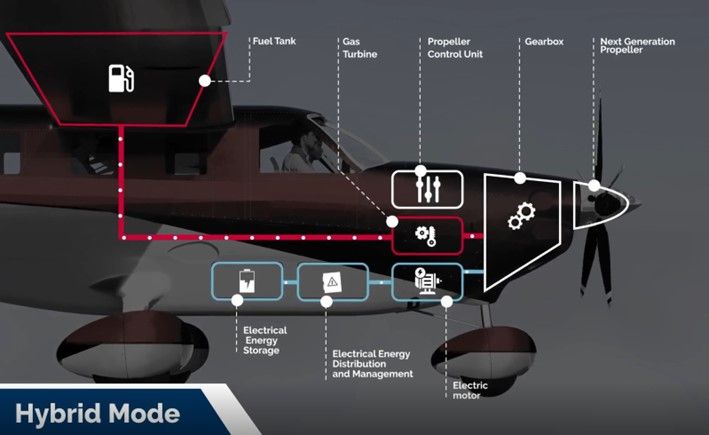A French aerospace consortium launches an initiative to develop hybrid-electric propulsion for general aviation

06/25/2025
Four major French aerospace companies today announced an ambitious collaborative research project to study and define a hybrid-electric propulsion architecture for light aircraft with optimized propeller efficiency, which is aligned with decarbonization goals set by the French Directorate General for Civil Aviation (DGAC) and the country’s CORAC civil aeronautics research council.
This consortium – comprising Daher, Safran, Collins Aerospace and Ascendance – fully supports national and international roadmaps for decarbonizing the aviation sector. The project specifically targets 6- to 10-seat aircraft. With 25,000 such aircraft in operation worldwide, this segment has been identified as a priority for initiating the ecological transition of air transportation by 2027.
The R&T project is named TAGINE, the French acronym for: “Tentative dans l’Aviation Générale d’Introduction de Nouvelles Énergies,” which translates as: “Initiative to introduce clean energy in general aviation.”
It is supported financially by CORAC and DGAC, and aims to assess the technical feasibility, economic viability, and decarbonization potential of such hybrid-electric propulsion architecture on a platform in the category of Daher’s Kodiak multi-role airplane. This innovative approach leverages the four partners’ complementary expertise:
- As the project leader, Daher brings its know-how as an aircraft architect (systems and structures) and its full range of original equipment manufacturer (OEM) capabilities, including safety, integration, and aircraft energy efficiency (CO₂ footprint). Daher also is providing its Kodiak aircraft as a use case for the hybrid-electric initiative.
- Safran, through Safran Helicopter Engines and Safran Tech, is studying the feasibility of a hybrid propulsion system based on a next-generation turbine and electric motor. This system will combine electric and thermal power to drive the propeller. The electric/thermal split will be optimized to achieve fuel savings and reduce noise and CO₂ emissions.
- Collins Aerospace is leading the aeroacoustic optimization studies for the propeller and contributing to the integration of the propulsion system and propeller. The company also is designing a fully electric pitch change system tailored to propellers in this power class. These activities aim to improve energy efficiency and reduce the propeller system’s overall mass.
- Ascendance contributes its expertise in hybridization and energy optimization by leveraging the company’s Hybrid Operating System to manage and control energy in a hybrid propulsion system. Ascendance also is responsible for identifying battery energy requirements for the applications studied in the project, and for integrating these batteries for hybrid-electric aircraft applications.
This collaboration, planned during a timeframe of more than two years, marks a significant step toward more sustainable aviation. Hybrid propulsion is a key building block for significantly reducing fuel consumption and optimizing the use of sustainable aviation fuels (SAFs). The first environmental impact assessment results are expected by the end of 2025, and the project’s major milestones will be presented at the next Paris Air Show.
Next key steps of the project:
- Performance and environmental impact assessment
- Feasibility study, including regulatory aspects
About Daher – www.daher.com
Daher is an aircraft manufacturer, industrialist, industrial services provider, and logistics specialist, employing more than 14,000 people with revenues of €1.8 billion in 2024. With a family shareholding structure, Daher has been innovation-driven since its founding in 1863. With operations in about 15 countries across Europe, North America, and Asia, Daher designs and develops value-added solutions for its aerospace and industrial clients and partners.
About Safran – www.safran-group.com
Safran is an international high-technology group operating in the fields of aerospace (propulsion, equipment, and interiors), space, and defense. Its mission: to contribute sustainably to a safer world, where air transport is increasingly environmentally friendly, comfortable, and accessible. Present on every continent, the Group employs 100,000 people and achieved revenues of €27.3 billion in 2024, holding leading global or European positions in its markets, alone or in partnership.
Safran is listed on Euronext Paris and is part of the CAC 40 and Euro Stoxx 50 indices.
Safran Helicopter Engines is the world leader in helicopter engine manufacturing, with over 75,000 engines produced since its founding. The company offers the widest range of turboshaft engines and serves 2,500 customers in 155 countries.
AboutCollins Aerospace – www.collinsaerospace.com
Collins Aerospace, a business of RTX, is a leading provider of integrated and intelligent solutions for the global aerospace and defense industry. Its 80,000 employees are committed to developing forward-looking technologies to advance sustainable and connected aviation, passenger safety and comfort, mission success, space exploration, and more.
About Ascendance – www.ascendance-ft.com
Founded in 2018 by Jean-Christophe Lambert, Thibault Baldivia, Clément Dinel, and Benoît Ferran, and supported by the Occitanie Regional Council, Bpifrance, and the France 2030 program, Ascendance is a start-up with a mission to decarbonize aviation. Based in Toulouse, Ascendance is currently developing STERNA, an innovative hybrid-electric propulsion solution, as well as a VTOL (vertical takeoff and landing) aircraft powered by STERNA, called ATEA. Designed as a low-carbon alternative to helicopters, ATEA targets regional air mobility applications such as passenger transport, cargo, medical emergencies, and security missions.
Media contacts:
Daher
Jeffrey Lenorovitz
Vice President – Communications
e-mail: j.lenorovitz@daher.com
Voir toutes les actualités